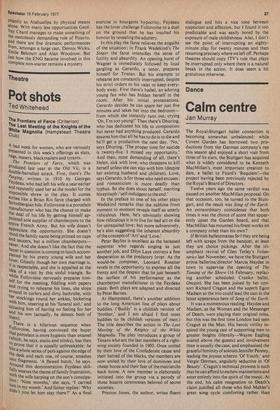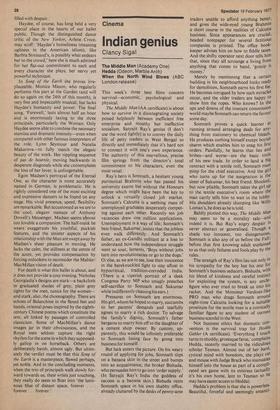Dance
Calm centre
Jan Murray The Royal-Stuttgart ballet connection is becoming somewhat unbalanced: while Covent Garden has borrowed two productions from the German company's rep this season arkid enjoyed a short visit from three of its stars, the Stuttgart has acquired what is widely considered to be Kenneth MacMillan's most important creation Co date, a ballet to Faure's 'Requiem'—the project having been previously rejected by the Royal's Board of Directors.
Twelve years ago the same verdict was passed on another MacMillan proposal. On that occasion, too, he turned to the Stuttgart, and the result was Song of the Earth. An extraordinary coincidence that both times it was the choice of score that apparently upset the Garden board, and that MacMillan has mounted his finest works on a company other than his own?
If British balletomanes ferl they are being left with scraps from the banquet, at least they are choice pickings. After the triumphant revival of Glen Tetley's Voluntaries last November, we have the Stuttgart prima ballerina/director Marcia Haydee in town to supervise the opening of The Taming of the Shrew (16 February, replacing another scheduled Cranko ballet, Onegin). She has been joined by her consort Richard Cragun and the superb Egon Madsen so the trio could lead the cast in the latest appearance here of Song of the Earth.
It was a momentous reading. Haydee and Madsen, as the Woman and the Messenger of Death, were playing their original roles, but this was the first time London had seen Cragun as the Man. His heroic virility inspired the young cast of supporting men to greater heights (literally—Wayne Eagling soared above the guests) and involvement than is usually the case, and emphasised the graceful feminity of soloists Jennifer Penney, leading the joyous scherzo 'Of Youth,' and Vergie Derman, angularly seductive in 'Of Beauty'. Cragun's technical prowess is such that he can afford to eschew mannerisms and enter entirely into the spirit of the music. At the end, his calm resignation to Death's claim justified all those who find Mahler's great song cycle comforting rather than filled with despair.
Haydee, of course, has long held a very special place in the hearts of our ballet public. Though the distinguished dance critic of the New Yorker, Arlene Croce, may scoff: 'Haydee's homeliness (meaning ugliness in the American idiom), like Barbra Streisand's, is possibly what endears her to the crowd,' here she is much admired for her flat-out commitment to each and every character she plays, her nervy yet powerful technique.
In Song of the Earth she proves irreplaceable. Monica Mason, who regularly performs this part at the Garden (and will do so again on the 24th of this month), is very fine and impeccably musical, but lacks Haydee's humanity and power. The final song, 'Farewell,' lasts almost half an hour and is enormously taxing to the three principals, particularly the Woman. Only Haydee seems able to combine the necessary stamina and dramatic intensity—even when compared with other famous interpreters of the role, Lynn Seymour and Natalia Makarova—to fully match the elegaic beauty of the work. Her rippling sequence of pas de bourree, moving backwards in desperate diagonals while she contemplates the loss of her lover, is unforgettable.
Egon Madsen's portrayal of the Eternal One, as the character is more accurately named in German, is problematic. He is rightly considered one of the most exciting and expressive dancers to be found on any stage. His vivid presence, speed, flexibility are remarkable. But accustomed as we are to the cool, elegant menace of Anthony Dowell's Messenger, Madsen seems almost too lovable a companion. The half-mask he wears exaggerates his youthful, puckish features, and the sinister aspects of his relationship with the Man are swept away by Madsen's sheer pleasure in moving. He lacks the calm, the stillness at the centre of the score, yet provides compensation by forcing onlookers to reconsider the Mahler/ MacMillan vision of death.
For death is what this ballet is about, and it does not provide a cosy evening. Nicholas Georgiadis's designs are stark—a backcloth in graduated shades of grey, plain grey tights for the men, tunics for the women— and stark, also, the choreography. There are echoes of Balanchine in the flexed feet and hands, oriental poses inspired by the eighthcentury Chinese poems which constitute the text, all linked by passages of controlled classicism. Some of MacMillan's dance images jar in their obviousness, and the Royal men seldom capture the right rhythm for the scene in which they supposedly gallop in on horseback. Others are deliberately harsh, almost ugly. But ultimately the verdict must be that this Song of the Earth is a masterpiece, flawed perhaps, yet noble. And in the concluding moments, when the trio of principals walk slowly forward towards us, their wrists just touching, they really do seem to float into 'the luminous blue of distant space, forever . . . forever . . . forever.'



































 Previous page
Previous page